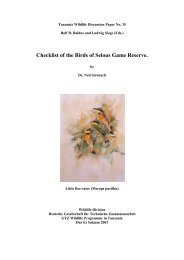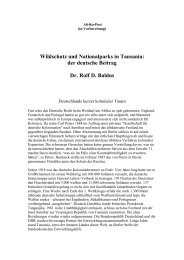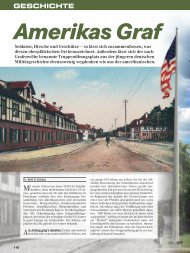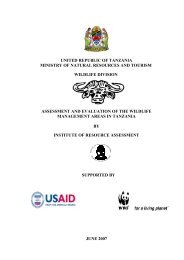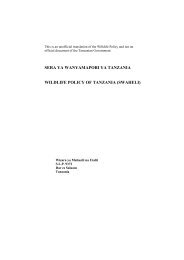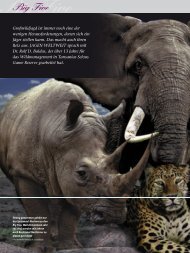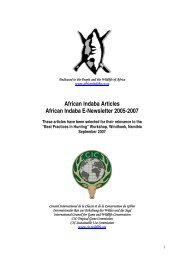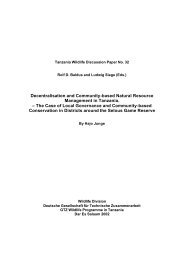TANZANIA NIASSA SELOUS MOZAMBIQUE - wildlife-baldus.com
TANZANIA NIASSA SELOUS MOZAMBIQUE - wildlife-baldus.com
TANZANIA NIASSA SELOUS MOZAMBIQUE - wildlife-baldus.com
You also want an ePaper? Increase the reach of your titles
YUMPU automatically turns print PDFs into web optimized ePapers that Google loves.
A Good Neighbour - Niassa Game Reserve<br />
The Niassa Game Reserve in neighbouring Mozambique is the largest conservation area in the country,<br />
covering 42,000 km 2 . It contains the greatest concentration of <strong>wildlife</strong> in Mozambique. The Ruvuma river<br />
forms the northern boundary of the Niassa Reserve and the border with Tanzania. The reserve consists<br />
of a core area of 22,000 km 2 and a support zone <strong>com</strong>prising an additional 20,000 km 2 .<br />
In contrast to the Selous there are a number of villages inside the protected area. This poses both a challenge<br />
and an opportunity to its management. The Niassa Reserve is managed through a public-private partnership,<br />
Sociedade para a Gestao e Desenvolvimento da Reserva do Niassa, with its current major donor and<br />
technical partner Fauna & Flora International.<br />
Selous – Niassa Wildlife Corridor<br />
The Selous-Niassa miombo woodland ecosystem as a whole is one of the largest trans-boundary ecosystems<br />
in Africa, covering 150,000 km 2 , and extends across southern Tanzania into neighbouring Mozambique.<br />
The many habitats, including forests, wooded grasslands, open savannahs, granite kopjes, seasonal and<br />
permanent wetlands and rivers support a wide biodiversity which is globally significant. The core conservation<br />
areas for its continued existence are:<br />
- the Selous Game Reserve<br />
- the Niassa Game Reserve<br />
- forest reserves<br />
Together these areas constitute the world’s largest elephant range. The corridor is central to this range.<br />
The corridor is sparsely settled by small farmers who have lived side by side with the <strong>wildlife</strong> since time<br />
immemorial. The task ahead will be to find a balance between their development needs and the conservation<br />
of nature. The long term existence of the corridor will be in their hands.<br />
However, there are severe threats to its continued existence which could block this important link. These<br />
include uncontrolled conversion of land for agricultural use, destructive agricultural practices, unsustainable<br />
and illegal use of natural resources, cross-border poaching, bush meat trade, illegal logging, destruction of<br />
forests and uncontrolled bushfires.



